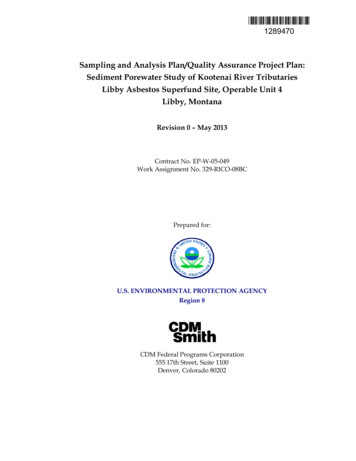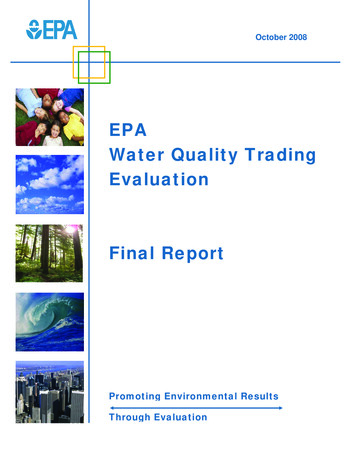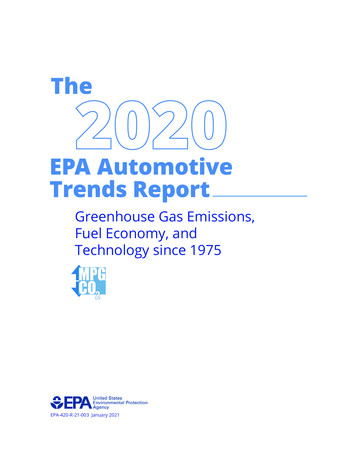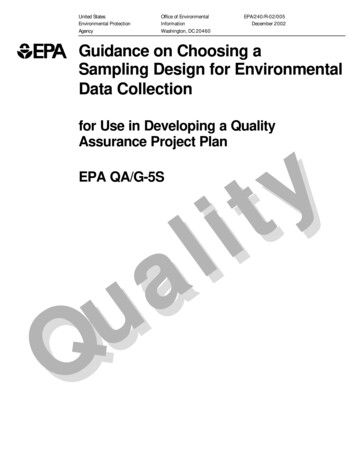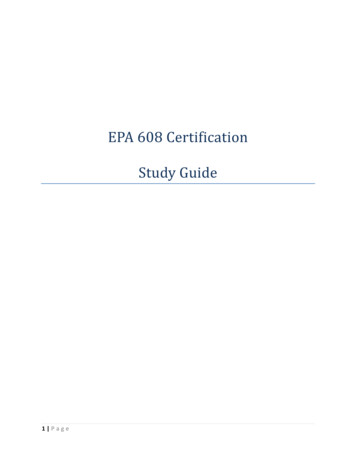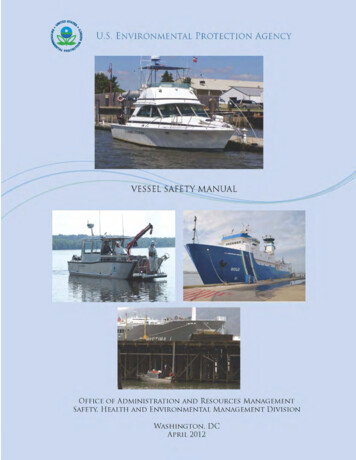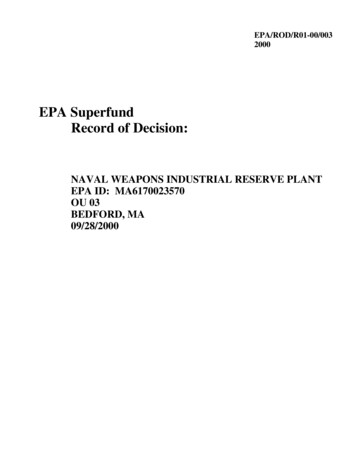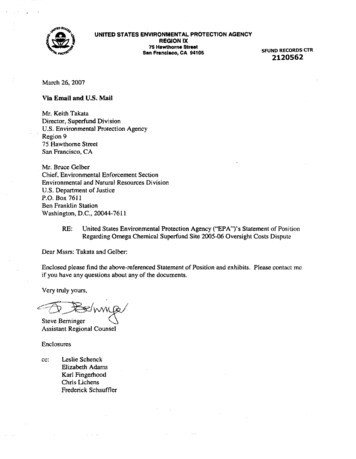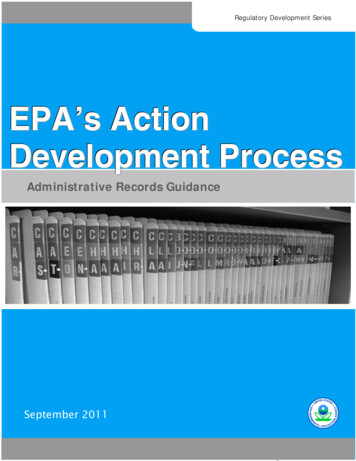
Transcription
Regulatory Development SeriesEPA’s ActionDevelopment ProcessAdministrative Records GuidanceSeptember 20111
Table of ContentsTable of Contents . 2What is the purpose of this document? . 3What is the “administrative record”? . 4Why are administrative records important? . 4What is the goal of the administrative record? . 5Why are deliberative materials not part of the record? . 5What kinds of documents are “deliberative”? . 6What documents should generally be in EPA’s administrative record? . 7What documents should generally not be in EPA’s administrative record? . 9How is the administrative record different from a docket or other publicly available viewing file?. 10When is the administrative record developed? . 11Who should develop and maintain the record? . 11What other Agency guidance is available relating to administrative records? . 122
What is the purpose of this document?This document describes EPA’s practices for compiling administrative records for use inlitigation challenging EPA decisions. The principles outlined below are intended to help informEPA personnel about basic principles for record compilation, provide information to the publicon how EPA compiles records, and to contribute to an orderly process for judicial review basedon a complete record. This document is consistent with the US Department of Justicerecommendation that agencies develop guidance on the compilation and contents of theadministrative record. (Memorandum from Ronald J. Tenpas, Assistant Attorney General, toSelected Agency Counsel, December 23, 2008.)Filing a complete administrative record is critical to defending EPA decisions in court.Where litigation is likely, it is also very important to focus on record development through theentire process of decision-making. This document reflects both case law and long-standingAgency practice in compiling and defending administrative records for EPA decisions. 1Specifically, this document is intended to: Clarify EPA’s practice regarding which documents would generally be included andwhich documents would generally not be included in the administrative record for anEPA decision that has been or will be challenged in Court and is reviewable under theAdministrative Procedure Act (APA). Provide assistance to EPA personnel in assembling these administrative records. Whiledecisions about what to include in an administrative record depend upon many factorsthat will be specific to each statutory mandate and decision-making process, there aresome general principles that should aid this process and reduce the time, effort andtransaction costs in assembling administrative records in response to a court challengeand in addressing the potential consequences of having an inadequate record. Enhance the defensibility of EPA decisions by ensuring that the underlyingadministrative record includes all relevant information that EPA considered and anynecessary responses to that information.The development of administrative records is a highly case-specific endeavor and theserecommendations do not address all questions concerning these administrative records.However, this document should provide clarity and assistance for the most often-asked questionspertaining to administrative records. Questions that are not addressed in this document should be1Note that some Agency programs have developed specific guidance for their programs or have statutory orregulatory provision that govern record compilation; for example, Comprehensive Environmental ResponseCompensation and Liability Act (CERCLA) response actions and Clean Water Act (CWA) State water qualitystandards (WQS) approval decisions. While this guidance is intended to be consistent with those programs, thosemore specific provisions or guidance concerning record compilation govern.3
referred to the Office of General Counsel (OGC) or Regional attorney working on a particularmatter. We may update this document as necessary to address additional issues. 2What is the “administrative record”?The administrative record filed with a court is the set of non-deliberative documents thatthe decision-maker considered, directly or indirectly (e.g., through staff), in making the finaldecision. 3 The record should include all the factual, technical, and scientific material or dataconsidered in making the decision, whether or not those materials or data support the decision. If the decision-making process included one or more public comment periods, theadministrative record will include all public comments submitted to EPA as part of thosecomment periods, whether or not those comments support EPA.Note that the “administrative record” for an action does not necessarily include alldocuments related to a matter that are official government records under the FederalRecords Act. For example, official internal memoranda related to an action may beagency records but not part of the “administrative record” because they are deliberative,as discussed below.Why are administrative records important?EPA’s decisions are generally subject to court review under the Administrative ProcedureAct (APA). The APA provides that review of agency actions is based on the “whole record.”When an EPA final action is challenged, EPA generally is required by the Court to file itsadministrative record with the Court and make the record available to the litigating parties. The administrative record is the “whole record” under the APA; it is where the courtslook to determine whether the agency action was reasonable and consistent withapplicable legal requirements. (For the leading Supreme Court case on judicial reviewof agency actions under the APA, please see Citizens to Preserve Overton Park v.Volpe, 401 U.S. 402 (1971)).The standard of review courts use when reviewing an agency action under the APA iswhether an agency action is “arbitrary, capricious, an abuse of discretion, or otherwise not inaccordance with law.” One frequently cited standard for making this determination is whether2Please note that this guidance is intended to address compilation of “administrative records” for purposes oflitigation challenging an Agency decision. It does not address record compilation and retention requirementspursuant to discovery orders or litigation hold memoranda; such compilations may be far broader than theadministrative record for the Agency action at issue.3A number of different phrases with the same meaning may be used interchangeably to describe the contents of theadministrative record. For example, the administrative record may be referred to as the set of documents that“provides the basis” or “forms the basis” for an action; that the agency or decision-maker “considered”; that thedecision-maker “considered either directly or indirectly”; or that the agency or the agency decision-maker “reliedon.”4
the decision was based on a consideration of the relevant factors and whether there has been aclear error of judgment. Overton Park at 416. Filing a complete record with the court helps theAgency demonstrate that it considered the relevant factors in making its decision and made areasonable judgment in light of all the relevant facts.There can be significant costs to the Agency in compiling an inadequate record. Anincomplete record may mean that the Agency action is overturned by a reviewing court orremanded for additional explanation. That in turn can require additional staff time and resources.In addition, some courts faced with an inadequate record will allow supplementation of therecord by the opposing parties or will allow discovery, which can also be very time- andresource-intensive. Compilation of a complete administrative record will help the Agency avoidthese adverse consequences in litigation.What is the goal of the administrative record?In assembling an administrative record for court review, the goal is to have anadministrative record that:(1) contains all non-deliberative 4 information EPA is aware of that is relevant to thedecision and that was considered directly or indirectly by the decision-maker, includinginformation that supports or is contrary to the action taken by EPA; and(2) explains why EPA’s action is reasonable and consistent with statutory and regulatoryrequirements, and specifically how EPA reviewed any contrary information and why EPA cameto the decision that it did notwithstanding that information.The administrative record should, as a result, fairly represent all relevant factualinformation and contrary views provided to the Agency. As noted above, it is very important tohave an adequate administrative record because the lack of an adequate record may result in anadverse court decision overturning the EPA decision or ordering supplementation of the recordthrough, for example, written discovery or depositions of Agency employees.Why are deliberative materials not part of the record?The administrative record does not include materials that solely reflect the internaldeliberative processes of decision-making within EPA or within the Executive Branch of thefederal government. In its seminal Overton Park decision on court review of Agency actionunder the APA, the Supreme Court held that judicial inquiry into the deliberative process of4A note on “deliberative” documents as opposed to “deliberative process privileged” documents: this guidancediscusses “deliberative” materials; while that term is also used in the Freedom of Information Act (FOIA) context torefer to documents subject to a “deliberative process privilege”, the use of the term “deliberative” in theadministrative record context is not related to a privilege. As noted below under “publicly available deliberativedocuments”, the exclusion of deliberative documents from the record is based on relevance, not privilege. Mostdocuments that are subject to a FOIA privilege (deliberative process, attorney-client, and work-product documents,for example) will also be excluded from the administrative record because they are internal and pre-decisional, andthus “deliberative”. However, a “deliberative” document does not need to be privileged in order to be excludedfrom the administrative record.5
decision-makers is not permitted. Because the actual subjective motivation of Agency decisionmakers is immaterial as a matter of law under Overton Park, documentation of the deliberationsis also immaterial. See e.g. San Luis Obispo Mothers for Peace v. NRC, 751 F.2d 1287, 1324-26(D.C. Cir. 1984) (noting weight of precedent and policy favoring exclusion of deliberativedocuments).As a result, materials containing solely the policy advice, recommendations, or opinionsof EPA or other federal government staff that were generated as part of the internal deliberativeprocess for formulating the EPA decision are not generally part of the administrative record.These types of materials are generally excluded because they document the Agency’s orExecutive Branch’s internal decision-making process and deliberations prior to the agency’sfinal decision rather than providing or explaining the information that forms the basis for thedecision.Exclusion of deliberative materials is also important for practical reasons, including thatrevealing candid pre-decisional views and advice would chill internal discussion of importantlegal and policy matters, thereby reducing the quality of decision-making, that disclosure ofinternal deliberations may be misleading as to the actual basis for the decision, and that EPAdoes not generally keep or track all the internal pre-decisional material (e.g. every draft of thedecision document) and to do so would be highly resource-intensive.Because EPA’s record will not generally include deliberative material, EPA should notrefer to or rely on any of these materials in its decision documents. Where information in adeliberative document is needed to provide record support --- for example, where the documentcontains factual information or records policy decisions found nowhere else in the record, orwhere a relevant document, while labeled “draft,” was not superseded by a final document --- therelevant information should be extracted and placed in a non-deliberative document (e.g.technical support document, memorandum to the record) before the final decision is issued. Thenon-deliberative document would be included in the administrative record; the deliberativedocument would not.What kinds of documents are “deliberative”?Deliberative documents are those that are prepared in order to assist an agency decisionmaker in arriving at a decision and reflecting preliminary or candid internal views or advice ofthe kind that would be discouraged if the document were made part of the record for thedecision. As discussed in more detail below, a “deliberative” document is one that is internal,that is pre-decisional, and that has deliberative content. Internal documents generally are documents (including emails) that are shared onlyamong EPA employees. There are a few exceptions: “internal” also includes documentsshared with other federal agencies during deliberations over the agency decision (but notformal memos or comments from another agency); documents generated by or sharedwith contractors working for the Agency on the matter; documents shared with co-6
regulators, such as States, where the co-regulator is acting solely as a consultant forEPA’s decision-making. Pre-decisional means the document must have been created before the decision. Draftsare usually pre-decisional. Documents announcing a decision are not. Deliberative content means that the document must reflect internal deliberations over apending Agency decision. Generally, documents expressing personal ideas, staffopinions, recommendations or advice are deliberative, as are options papers, issue papers,management briefing documents, edits or comments on draft documents, draft decisionand supporting documents. Documents that are factual are rarely deliberative.Documents conveying or explaining decisions are usually not deliberative. If a“recommendations” document is treated as a decision document (e.g. it is signed by thedecision-maker), it is not deliberative. Documents providing solely non-substantive orfactual information, such as meeting location, logistics, planning documents and meetingagendas are not generally deliberative. Documents that include both deliberative material and non-deliberative material (e.g.,technical analysis or factual or scientific information) should be discussed with OGC orRegional attorneys; to the extent practicable, the scientific or factual material should becopied into a non-deliberative document and placed in the record.Because the administrative record does not include deliberative documents, it would notgenerally include materials such as staff notes, internal e-mails discussing or evaluating variouspolicy options or decision drafts, briefing papers and other staff advice, draft decisiondocuments, staff attorney opinions or work product, or emails exchanging preliminary opinionsor recommendations. These materials are excluded as deliberative regardless of whether theyevidence conflicting opinions on the merits of scientific, technical or policy issues, containrecommendations for options not ultimately adopted by the Agency, or document preliminaryviews of the decision-maker that differ from the agency’s final decision. The administrative record should, however, include the scientific or technical literature,technical analysis, and other factual information considered by the decision-maker,including his/her staff, in developing the Agency’s final position. Such factual materialis not usually considered to be deliberative. OGC or Regional attorneys should beconsulted if the status of a possible record document is unclear.What documents should generally be in EPA’s administrative record?Following are the major categories of materials that should be in decision records filed incourt challenges to those decisions 5:5Note that some programs have regulations that require specific items to be in an administrative record for thoseprograms. For example, 40 CFR 124 specifies certain materials to be included in the administrative record for draftand final National Pollutant Discharge Elimination System (NPDES), Resource Conservation and Recovery Act7
EPA information considered in connection with the decision, including: the proposedaction (if the decision was preceded by a public proposal), supporting technicalinformation and analyses, reports, data files, graphs, charts, guidance, manuals, policiesand directives, official meeting notes or transcripts, and documents shared between EPAand outside parties. The record also includes documentation to support findings underrelevant statutory authorities, regulatory authorities, or executive orders, such as theeconomic analysis prepared pursuant to Executive Order (EO) 12866, analyses of theeconomic impacts on small entities prepared under the Regulatory Flexibility Act, andrecords of consultations required by the Unfunded Mandates Reform Act andconsultations undertaken pursuant to EPA’s tribal policy. Public process materials including: correspondence with members of the public,transcripts from hearings, public comments submitted to EPA, and the responses to thosecomments. Information shared with States. Except in the unusual case where a State is actingsolely as EPA’s consultant during a decision-making process, documents generated by,with, or shared among EPA and State personnel that are considered by EPA inconnection with the decision are not likely to be considered “deliberative.” As a result,these documents should be in the administrative record even if the document is draft orreflects preliminary discussions between EPA and State personnel. Consult with OGC orRegional attorneys to determine the status of documents from, or shared with, Stateofficials. Other material EPA personnel considered in connection with the decision, includingcorrespondence and emails from other federal agencies that provide factual, scientific ortechnical information related to the decision or that reflect the other agencies’ officialviews about the EPA decision (e.g., under the Endangered Species Act (ESA), finalbiological opinions or concurrence on effects determinations); documents generated byEPA that memorialize phone calls that provided relevant factual information or publiccomments not otherwise provided in written form; and hard copy printouts of any websiteinformation that is cited in the decision or relied on. As discussed below, some interagency correspondence may be both deliberative (for example, expressing staff opinions)and non-deliberative (for example, providing technical information or decisions). Onlythe non-deliberative information is part of the record. References. The record should also include the references cited in the decision,including court opinions and official EPA documents, as well as the important referencesthat are cited in scientific papers upon which EPA relied. While cited references can alsobe considered part of the administrative record without being listed separately, it is bestto separately include them to be clear about which documents EPA considered in its(RCRA), Underground Injection Control (UIC) and Prevention of Significant Deterioration (PSD) permits, and 40CFR Section 300.810 specifies the contents of the administrative record for a CERCLA response action.8
decision-making process. Note that copyright may affect how we make referencedmaterial available, but does not affect whether it is part of an administrative record. Confidential business information (CBI). The administrative record should includeCBI if that information was considered during the decision-making process. CBImaterials are listed in the index to the record, but the documents are generally eitherredacted or placed in a secured (not publicly accessible) portion of the record. As muchof the CBI material as possible should be made available through redaction or some othertechnique that shields the confidential information. This approach protects the CBIinformation while making the general information available to the public and the courts. 6 EPA’s final decision document. The final decision document is the document signed bythe Agency official authorized to make the decision, such as the final rule signed by theAdministrator, or the final determination or approval/disapproval document.What documents should generally not be in EPA’s administrative record?Following are the principal types of documents that should not be included in decisionrecords. Intra-agency deliberative documents. As discussed above, these are documents andemails generated prior to the decision and containing solely internal pre-decisionaldeliberations related to the decision, such as emails between EPA program staff andattorneys related to the decision, options papers, personal notes documenting internalmeetings, and drafts of the decision document and comments by EPA personnel on thatdocument. Deliberative information contained in a non-deliberative document should beextracted; only the non-deliberative portions of the document should be included in therecord. Inter-agency deliberative documents. Deliberative materials shared between EPA andother federal government agencies that EPA is consulting with as part of the decisionmaking process (for example, the Office of Management and Budget (OMB)) are treatedthe same as internal EPA documents. Factual, scientific, and technical information is partof the record; staff advisory opinions or advice made as part of the decision-makingprocess are not part of the record. Note that comments from OMB are deliberative andare not part of the administrative record whether are not they were made available in thedocket.o However, official memoranda from another federal agency are not deliberative,and should be included in the administrative record, if they were sent as part ofconsultations required by statute or regulation and if they express the otheragency’s final views on the EPA decision or a particular stage of the decision(such as a final biological opinion from the US Fish and Wildlife Service or the6CBI status is governed by EPA regulations found at 40 CFR Part 2, Subpart B. Always consult with your OGC orRegional attorney when handling any CBI material.9
National Marine Fisheries Service). OGC or Regional attorneys should beconsulted on whether correspondence or a document from another federal agencyis deliberative; EPA staff may also need to contact the other agency to determinewhat their intent was. Note that some transmittals from other agencies maycontain both factual information and deliberative material, such as a deliberativecover memorandum attaching a non-deliberative report or study. In such case,the report or study would be in the record but the cover memorandum would notbe in the administrative record. Publicly available deliberative documents. For purposes of compiling administrativerecords, a document remains “deliberative” even if it has been made public; decisionsregarding what documents are part of EPA’s administrative record do not depend onwhether the documents are “privileged” or have been released to the public as part of adocket or in response to a FOIA request. Documents generated after signature. The administrative record for a decision iscomplete upon signature by the decision-maker. Documents generated or altered aftersignature are not part of the administrative record for that decision. 7 Similarly, FOIArequests about a decision are not part of the record of the decision itself.How is the administrative record different from a docket or other publiclyavailable viewing file?Unless a statute or regulation provides otherwise, the docket and the administrativerecord may contain slightly different sets of documents. A docket is a collection of documentsthat are made available for public viewing. Under some circumstances, some of the documentsplaced in the docket would not be included in the administrative record. For example, if thedocket contains late comments received after the comment period, the administrative recordwould only include those comments if the Agency in fact considered them.At the same time, because the administrative record is the compilation of all non-deliberativematerials considered by the Agency during a decision-making process, a non-deliberativedocument that was considered by the Agency is part of the record regardless of whether it was inthe docket or other publicly-available file. For example, a document classified as CBI wouldgenerally not be placed in the docket but would be part of the administrative record. In addition,some Agency decisions subject to litigation (such as a guidance document or a variance decision)may not have a public docket at all.7Under Agency policy for rulemakings signed by the Administrator, clerical errors that do not affect the substanceof the rule can be corrected without review and approval by the Administrator but substantive changes must beapproved by the Administrator. See hanges-postsig07-25-06.pdf.Such post-signature changes are not generally part of the administrative record for the original decision; rather, theyshould be considered part of a supplemental record.10
Note that if an action has a docket, it is a good practice to make the docket and record asmuch the same as possible to reduce confusion and the need to explain the differencebetween the two compilations. Also note that under Clean Air Act (CAA) Section 307(d) and Toxic Substances ControlAct (TSCA) Section 411, a promulgated rule may not be based on any information whichhas not been placed in the docket. Generally, this means that as of the date a CAA 307(d)or TSCA 411 final rule is signed, all materials that make up the administrative record forthe rule must be in the docket.See EPA’s Creating and Managing Dockets: Frequently Asked Questions for EPA ActionDevelopers for more information docketing.htm).When is the administrative record developed?While the record is not officially compiled until a court orders the Agency to file therecord in litigation, it is important to focus on the record through the entire decision-makingprocess. 8 A deficient record cannot generally be cured by creating new supporting documentsafter the decision-maker has signed the decision. For example, it is important to have writtenresponses in the record to scientific, technical or policy criticisms of the decision that are in therecord. These responses, and all record documents, must be completed before the decisionmaker has signed the decision document.Note also that a compilation of materials in a docket or other publicly available viewingfile does not dictate what is or is not in the final administrative record. A docket or viewing fileis compiled during a decision-making process to provide the public with access to relevantAgency materials for comment or transparency. While that compilation may be similar to theadministrative record, the record is not formally certified until litigation. There may be materialsin the final administrative record that were not in the public file (e.g. CBI, physical items), andthere may be documents in the public file (e.g. comments received too late for consideration,OMB changes) that are not part of the record.Who should develop and maintain the record?Responsibility for development and maintenance of the administrative record varies bytype of decision and program office. At EPA Headquarters, developing and maintaining therecord is usually the responsibility of the lead program office for the action in question. In someRegional offices, there is a central record coordinator who manages administrative records forthe entire Regional office. Either structure is acceptable. Where an action involves multipleoffices, the lead office should make sure that necessary record documents are obtained from all8As a matter of efficiency, some offices choose to compile the record at the time of decision rather than waiting forlitigation.11
persons who participated in the decision-making process. For example, if a Region is compilingan administrative record to support a regional CAA action, they may also need to obtain relevantdocuments from the Office of Enforcement and Compliance Assurance (OECA) and the Officeof Air Quality Planning and Standards (OAQPS).Unless otherwise provided for in a particular Agency program, the person who certifiesthe record for litigation should generally be the highest level career manager with oversightresponsibility for the action for which the record is developed; at Headquarters, that wouldgenerally be the relevant office director. For Regional offices, this would generally be therelevant division director.
If the decision-making process included one or more public comment periods, the administrative record will include all public comments submitted to EPA as part of those comment periods, whether or not those comments support EPA. Note that the "administrative record" for an action does not necessarily include all
